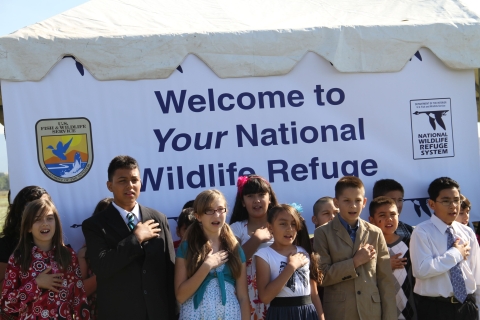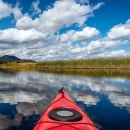Management and Conservation
In 2013 the U.S. Fish and Wildlife Service established the Urban Wildlife Conservation Program through Director’s Order No. 208 and a subsequent policy (110 FW 1), with the goal of prioritizing conservation and recreational access in urban and suburban areas where more than 80 percent of Americans live.
Strategic Investments Pay Off
Since 2013, with limited funds, the Refuge System has built seven
flagship urban national wildlife refuges and supported 32 designated urban partnerships. These innovation centers model strategies to increase access to nature.
- Bringing conservation home. John Heinz National Wildlife Refuge at Tinicum in Philadelphiais working with local communities to turn
vacant neighborhood lots into vibrant green spaces and take nature lessons into schools. It is also soliciting community feedback on programs. (More on John Heinz Refuge below.) - Conservation and health. Valle de Oro National Wildlife Refuge in Albuquerque, New Mexico, integrates environmental impacts into its strategic plan. The refuge’s blueprint for wildlife restoration and community health addresses the effects of pollution on the adjacent Mountain View neighborhood. (More on Valle de Oro Refuge below.)
- Career training. Living-wage internships at several urban refuges are helping to mold the next generation’s conservation leaders.
- Improving resilience. National wildlife refuges in the Portland-Vancouver metro area are working with local communities on large-scale habitat restoration to ease flooding. The projects capture storm water runoff from heavy rainstorms, help prevent flood damage in at-risk areas and maintain habitat for native wildlife species.
Success Stories
Fish and Wildlife Service partnerships in cities like Houston, Providence, Baltimore and Elizabeth, New Jersey, where there are no nearby national wildlife refuges, also foster education and access to nature and outdoor recreation.
The Houston Community Partnerships and Engagement program provides virtual field trips to young people bedridden in hospitals and health facilities. “Virtually Wild! Texas” takes viewers to coastal wetlands, forests, prairies and zoos via their personal electronic devices. Viewers can interact directly with conservation professionals on camera.
In Chicago, an urban partnership trains residents to connect their local communities with nature through guided nature hikes, field trips, outdoor activities, and restoration projects.
Urban partnerships, like those at Santa Ana National Wildlife Refuge in Texas and Desert National Wildlife Refuge in Nevada, have helped neighboring schools and communities create pollinator gardens and other green spaces.
Scores of urban refuges host regular events to introduce kids and adults to fishing and birding.
Refuges in Texas, Colorado, Washington and California have built bridges and trails to better connect nearby cities with green space.
Every year, Lenape National Wildlife Refuge Complex's partnership with Groundwork Hudson Valley and Groundwork Elizabeth gives some 30 teens in Yonkers, N.Y. and 45 teens in Elizabeth, N.J. three weeks of conservation training at three national wildlife refuges (Cherry Valley, Great Swamp, Wallkill River). The teens use that training to promote conservation and green spaces in their home communities. More than 900 youth have benefited over the past 12 years. Thousands more residents have benefited from environmental education and habitat restoration.
John Heinz National Wildlife Refuge at Tinicum partners with community leaders and organizations in Southwest Philadelphia to build lasting relationships. The Philly Nature Kids program teaches natural science to fourth graders at three city schools. A high school work experience program employs up to 30 kids a year in paid internships; these jobs merge into five-to-eight college-level positions each year. Listening and engagement sessions help the refuge better understand community recreation needs. Since 2013 the program has served more than 17,000 kids and adults.
AtValle de Oro National Wildlife Refuge in New Mexico, partnerships with local schools, youth corps and community groups have helped build trails from a neighboring industrial Albuquerque neighborhood to the refuge, provide field trips for students, and build a community garden that emphasizes traditional seeds and foods.
Since 2014, refuge partnerships with groups including the Rocky Mountain Youth Corps and the Ancestral Lands Conservation Corps have employed more than 500 youth.
In collaboration with partners, the refuge hosts annual career fairs, job shadow opportunities and mentor mixers, supports the New Mexico Green Jobs listserv and will soon open a Center for Conservation Careers office in its new visitor center.
Our Programs
Our Projects and Research
Learn more about the research that makes the Urban Wildlife Conservation program possible.








